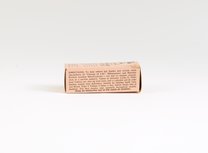Lydia E. Pinkham Menstrual Relief Tablets
- After 1882 – before 1968

Rights
 BY 4.0
BY 4.0Download all 2 images
PDFZIPof full-sized JPGsDownload selected image
Small JPG1200 x 1316px — 72.4 KBLarge JPG2880 x 3159px — 271 KBFull-sized JPG4493 x 4928px — 575 KBOriginal fileTIFF — 4493 x 4928px — 63.4 MB
 This work is licensed under a Creative Commons Attribution 4.0 International License.
This work is licensed under a Creative Commons Attribution 4.0 International License.Lydia E. Pinkham brand menstrual pain relief tablets, containing extract of Piscidia Erythrina (Jamaica Dogwood), Asclepias Tuberosa (Pleurisy Root), Glycyrrhiza (Licorice), and Ferrous Sulfate.
Lydia E. Pinkham, née Estes, (1819-1883) was an American proprietor who commodified her homemade herbal-alcoholic supplements, claiming they could cure any “female complaint” from menstrual discomfort to a prolapsed uterus. Pinkham began making her medicine as a home remedy, which she freely shared with family and friends. In 1875, her “Vegetable Compound” made its debut commercial appearance for $1 a bottle. In Pinkham’s life, the business grew from her cellar kitchen to a manufacturing plant that would gross just under $300,000 a year. The product is still sold today in a modified form.
Though medical experts dismissed Pinkham’s products as quack remedies, the supplements’ popularity among women persisted. Aggressive marketing of Pinkham's products contributed to their acceptance by women; slogans such as “Only a woman can understand a woman’s ills,” targeted the many women who were hesitant to consult male physicians about menstruation or other women’s health issues.
| Property | Value |
|---|---|
| Creator of work | |
| Provenance |
Gift of Allen Lopez. |
| Place of manufacture | |
| Format | |
| Genre | |
| Medium | |
| Extent |
|
| Language | |
| Inscription |
|
| Subject | |
| Rights | Creative Commons Attribution 4.0 International License |
| Credit line |
|
Institutional location
| Department | |
|---|---|
| Physical container |
|
Learn More
Related Items
Cite as
Science History Institute. Lydia E. Pinkham Menstrual Relief Tablets. Photograph, 2023. Science History Institute. Philadelphia. https://digital.sciencehistory.org/works/odaldrb.
This citation is automatically generated and may contain errors.






